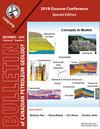基于井数据热地层和沉降模拟的Davis海峡地区(格陵兰西部和巴芬/拉布拉多东部共轭被动边缘)盆地演化:构造演化和含油气系统的意义
Q3 Earth and Planetary Sciences
引用次数: 9
摘要
戴维斯海峡地区沉积盆地主要受晚中生代和新生代裂陷作用的影响,形成了西格陵兰、巴芬东南部和拉布拉多东部大陆边缘。该地区最近获得的区域地球物理资料为沉积盆地和地壳厚度以及板块运动重建提供了相当多的新约束。此外,对Labrador北部边缘几口井的年代地层和镜质组反射率数据进行了重新对比和校正。考虑到这一点,计算了位于西格陵兰和东巴芬/拉布拉多共轭边缘的一些勘探井的沉降和热演化的新的一维模型。基于岩石圈延伸的模型预测与格陵兰岛西部、巴芬东南部和拉布拉多东部井观测到的地层和热数据吻合良好。这些井的计算拉伸系数非常相似,除了巴芬岛东南部的那些井更高。这表明,在古新世早期岩浆活动开始之前,该地区受到了更强烈的裂谷作用。反过来,这可能表明岩浆活动与裂谷作用有关,而不是像通常认为的那样,与古新世开始时地幔柱的到来有关。模拟的热历史表明,最大地下温度发生在整个新生代的不同时期,主要取决于沉积(埋藏)历史、地表温度和热流。因此,该地区的生烃预测必须包括这些参数。本文章由计算机程序翻译,如有差异,请以英文原文为准。
Basin evolution in the Davis Strait area (west Greenland and conjugate east Baffin/Labrador passive margins) from thermostratigraphic and subsidence modelling of well data: implications for tectonic evolution and petroleum systems
Abstract The sedimentary basins of the Davis Strait area developed mainly as a result of late Mesozoic and Cenozoic rifting processes that led to the formation of the West Greenland, southeast Baffin, and east Labrador continental margins. Recently acquired regional geophysical data in the area provide considerable new constraints on sedimentary basin and crustal thicknesses as well as plate kinematic reconstructions. Further, the chrono-stratigraphy and vitrinite reflectance data for several of the northern Labrador margin wells have been re-correlated and corrected. Given this, new 1-D models for the subsidence and thermal evolution of a number of the exploration wells located on the conjugate West Greenland and east Baffin/Labrador margins have been computed. Model predictions based on lithospheric extension agree well with observed stratigraphic and thermal data from West Greenland, southeast Baffin, and east Labrador wells. Calculated stretching factors for the wells are remarkably similar, except for those off southeast Baffin Island, which are higher. This implies that this area was subject to more intense rifting prior to the onset of magmatism in the early Paleocene. In turn, this may suggest that the magmatism was related to rifting and not, as commonly believed, linked to the arrival of a mantle plume at the beginning of the Paleocene. The modelled thermal histories indicate that maximum subsurface temperatures occurred at different times throughout the Cenozoic, depending mainly on the sedimentation (burial) histories, surface temperatures, and heat flow. Prediction of hydrocarbon generation in the area must therefore include these parameters.
求助全文
通过发布文献求助,成功后即可免费获取论文全文。
去求助
来源期刊

Bullentin of Canadian Petroleum Geology
Earth and Planetary Sciences-Geochemistry and Petrology
CiteScore
2.50
自引率
0.00%
发文量
0
期刊介绍:
The Bulletin of Canadian Petroleum Geology is a peer-reviewed scientific journal published four times a year. Founded in 1953, the BCPG aims to be the journal of record for papers dealing with all aspects of petroleum geology, broadly conceived, with a particularly (though not exclusively) Canadian focus. International submissions are encouraged, especially where a connection can be made to Canadian examples.
 求助内容:
求助内容: 应助结果提醒方式:
应助结果提醒方式:


